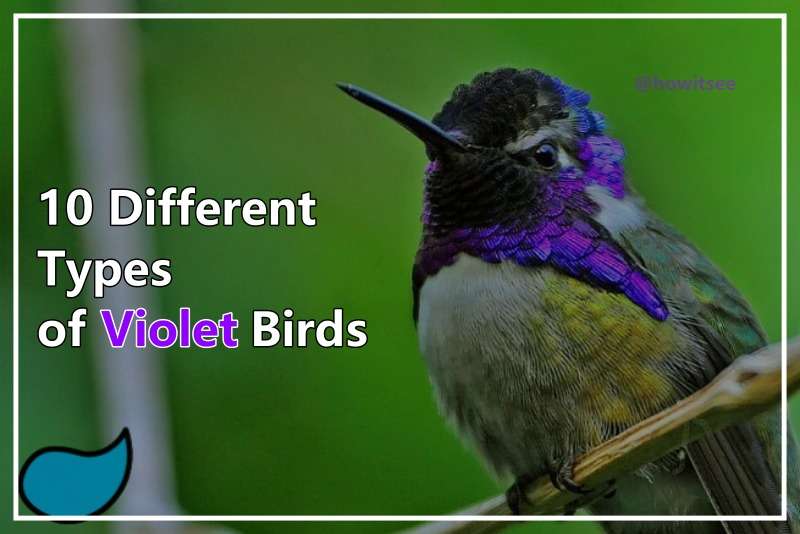Birds come in different shapes, sizes, and colors, with some of the most remarkable being those that feature a brilliant violet tint. If you love birds or are just interested in the variety of bird species, you might be wondering if any violet birds exist.
Unanimously, the response is yes! In fact, there are several distinct sorts of birds that flaunt gorgeous violet plumage. We will examine ten distinct species of violet birds in this post, from well-known to less well-known ones, and learn what makes each one special.
So let’s get started with the article.
Are there any Violet Birds & How is Violet different from Purple?
There are various types of bird species that have violet plumage. Some of them are the Violet-backed Starling, Violet-bellied Hummingbird, and Violet-crowned Woodnymph.
The distinction between violet and purple is that violet has a shorter wavelength and is closer to blue than purple. Violet has a higher frequency and appears brighter than purple, a composite hue created by blending blue and red. Violet is a bluish-purple color, whereas purple is a reddish-blue.
10 Different Types of Violet Birds
1. Violet-Backed Starling

| Scientific Name | Cinnyricinclus leucogaster |
| Size | 20-24 cm (8-9.5 in) |
| Life Span | 5-10 years |
| Geographic Location | Sub-Saharan Africa, from Senegal to Ethiopia and south to Angola and Zambia |
| Diet | Omnivorous, with a diet consisting of insects, fruits, nectar, and seeds |
The violet-backed starling is a sexually dimorphic species with adults measuring around 24 cm in length (8 in).
The male has pure white underparts and an iridescent violet head and back. The female resembles a thrush, with brown, boldly streaked upper parts and white, extensively streaked underparts.
Yellow irises and black bills and legs distinguish both sexes. The violet-backed starling eats fruits, seeds, and arthropods.
It hunts insects in the same way that flycatchers do. It primarily forages in the canopy, rarely feeding on the ground.
2. Golden-Chevroned Tanager
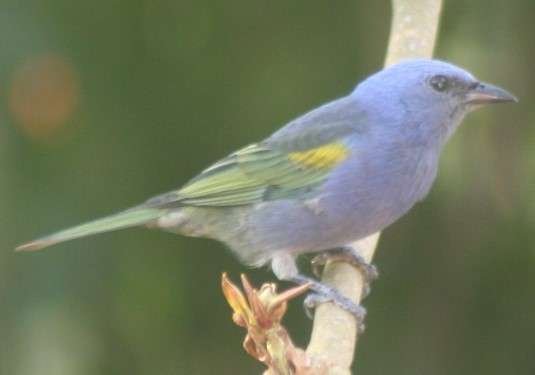
| Scientific Name | Habia rubicauda |
| Size | 14-16 cm (5.5-6.3 in) |
| Life Span | Up to 6 years |
| Geographic Location | Central and South America |
| Diet | Insects, fruit, nectar, and small arthropods |
The bill of this large violet-blue and yellow tanager is thinner than that of other related species.
Males have predominantly blue feathers with yellowish margins on the wing feathers and tail. Females are generally duller and grayer. Both sexes have distinctive yellow shoulders.
It can be found in the canopy of moist forests and on the edges of such forests, where it frequently joins with flocks of different species or gathers in single-species groups of up to 25 people.
3. Lilac-Breasted Roller
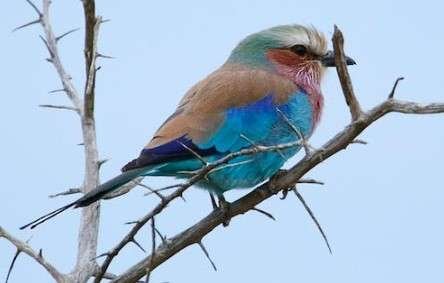
| Scientific Name | Coracias caudatus |
| Size | 14-15 inches (36-40 cm) |
| Life Span | Up to 15 years in the wild |
| Geographic Location | Sub-Saharan Africa |
| Diet | Insects, small animals (such as lizards and rodents), and occasionally fruits and seeds |
It prefers open woods and savanna, and it is for the most part missing from treeless locations.
It is typically found alone or in pairs, and it perches at the tops of trees, poles, and other high locations from which it may see small animals such as insects, amphibians, and birds moving about on the ground. It has multi-color wings and violet is also there.
Nesting takes place in a natural hole in a tree where a clutch of 2–4 eggs are placed and incubated by both parents, who are quite aggressive in defense of their nest, taking on raptors and other birds.
4. Splendid Sunbird
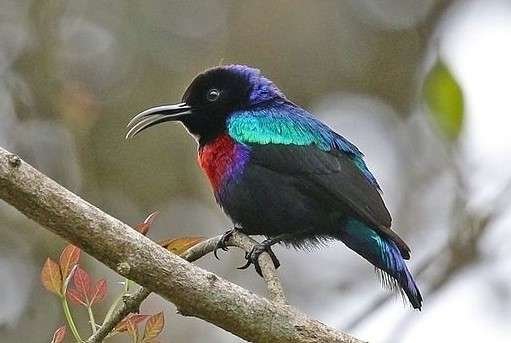
| Scientific Name | Cinnyris coccinigastrus |
| Size | 15 cm |
| Life Span | Up to 6 years |
| Geographic Location | Eastern and Southern Africa |
| Diet | Nectar, insects, and spiders |
The sunbirds are a group of very small Old World passerine birds who feed mostly on nectar, although they will occasionally take insects, especially when feeding young.
Its small wings allow for a swift and direct flight. Although the majority of species can feed by hovering like hummingbirds, they typically perch to eat most of the time. It has also multi-color plumage and you can see the violet color on the top part of its wings.
The magnificent sunbird breeds in eastern and southern tropical Africa. In an oval, tree-mounted suspended nest, one or two eggs are placed. It is a seasonal migratory within its range.
5. Violet-Bellied Hummingbird
Violet-bellied Hummingbird dares you to burn out your retinas on his glorious searing violet belly. He may also cut you. pic.twitter.com/0DOHh3fsSs
— Dr. Lisa Buckley 🦖🦃🐾🐾 (@Lisavipes) February 24, 2018
| Scientific Name | Chlorestes julie |
| Size | 9-10 cm |
| Life Span | Up to 6 years |
| Geographic Location | Costa Rica, Panama, and Colombia |
| Diet | Nectar from flowers, insects, and spiders |
The male of the violet-bellied hummingbird has a dazzling violet belly. The rest of its body is as bright, with a metallic green back and crown.
Due to sexual dimorphism in this species, the violet belly is not shared by the sexes. They do have similar traits, such as long, rounded tails, short, straight bills, and pink lower mandibles.
6. Violet-Crowned Woodnymph
| Scientific Name | Thalurania colombica |
| Size | 9-10 cm (3.5-4 in) |
| Life Span | Up to 8 years |
| Geographic Location | Central and South America |
| Diet | Nectar, small insects, spiders |
Their abdomen, upper back, and forehead are all violet. The nape is dark bronzy green and the lower back and rump are dark bluish green. Also, their chest and throat are green with glitter.
Their blue-black tail has a deep fork. Mature females have lighter grey bellies, necks, and chests with vivid green upper parts.
The tail is blue-black with white tips on the outer three pairs of feathers. Immature males have a dusky crown, necks, and underparts with very limited iridescent violet feathers. Female immatures have underparts that are totally pale grey and upperparts that are dull green.
7. Purple Honeycreeper
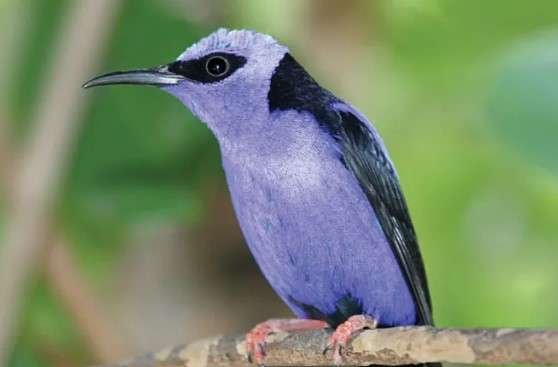
| Scientific Name | Cyanerpes caeruleus |
| Size | 10-11 cm (4-4.3 in) |
| Life Span | 5-6 years |
| Geographic Location | Central and South America, Colombia, Venezuela and Brazil |
| Diet | Nectar, insects, and fruit |
The male is violet with black wings, a tail and belly, and bright yellow legs. Females and immatures have green upper parts and green-streaked yellowish-buff underparts.
The throat is cinnamon, and there is a blue moustachial stripe. The call of purple honeycreeper is a thin high-pitched “zree.”
The purple honeycreeper is generally encountered in small groups. It feeds on nectar (especially from bromeliad and related flowers, to which its bill shape is adapted), berries and seeds (i.e., Trema and Clusia), fruit (i.e., bananas and papayas), and insects, mainly in the canopy.
8. Purple Gallinule

| Scientific Name | Porphyrio martinicus |
| Size | 26-37 cm(10-15 in) |
| Life Span | Up to 9 years in the wild |
| Geographic Location | Southern United States, Central America, South America |
| Diet | Omnivorous, feeds on plants, insects, small fish, and other invertebrates |
An adult purple gallinule has violet-blue plumage that will shimmer green and turquoise when in ideal lighting. Adults also have a pale blue shield on their forehead, which connects with the red and yellow bill.
Darkness or low light can dim the bright violet-blue plumage of the adult to make them look dusky or brownish, although the forehead shield color differentiates them from similar species such as common gallinules.
The bill and forehead shield of immature purple gallinules are pale in color, and they have violet feathers on their chest. Juvenile birds are light brown with hints of green-bronze on the wings and back and white under-tail coverts.
9. Purple Grenadier

| Scientific Name | Granatina ianthinogaster |
| Size | 13.3 cm (5.25 in) |
| Life Span | Up to 6 years |
| Geographic Location | Eastern Africa |
| Diet | plants, insects, fish |
A distinctive and attractive waxbill with a deep violet-blue tail and a red bill. The coloration of males is more vibrant, with a rufous hood, a violet belly, and violet and red areas around the eyes. Females are predominantly rufous with pale blue spots above and below the eye.
Found in a variety of savanna and woodland habitats, often in small flocks, sometimes mixed with other species. Gives high-pitched squeaking and rattling calls and a lisping, whistled song.
10. Violet Sabrewing
| Scientific Name | Campylopterus hemileucurus |
| Size | 13 to 15 cm (5.1 to 5.9 in) |
| Life Span | Up to 6 years |
| Geographic Location | Central and South America |
| Diet | Nectar from flowers, small insects, and spiders |
The nominate subspecies’ males have a bluish-green gloss on their dusky heads. Their nape and upper back, face, and underparts are metallic violet blue that is somewhat bluer on the belly.
Their upper-tail coverts and lower back are metallic green. The majority of their tail feathers are blackish with large white tips, with the center being blue-green to bluish-black.
Females have a dark crest and metallic green to bronze-green upperparts with a brighter blue-green rump. Their neck is violet-blue in color.
Their underparts are predominantly grey with a whiter belly and metallic green markings along the sides and green under-tail coverts. Its primary tail feathers are bluish-green and the remainder blacker with broad white tips.
In conclusion, several distinct species of violet-colored birds truly exist across the globe. Though not every one of them is totally violet, they are easily identifiable because of the violet highlights in their markings or feathers.
Each of these birds is gorgeous in its own way, from the delicate Violet-crowned Woodnymph to the lively Violet-backed Starling.
Whether you are a keen birdwatcher or simply admire the beauty of nature, the violet birds on this list are sure to captivate your attention and leave a lasting impression.
References:
- ebird.org
- Wikipedia
- fandom.com
Also Read:

A writer who studied agriculture. Nature has always drawn me in, and my main goal in writing about it is to discover some of its secrets. You can usually find me reading Bengali and English masterpieces or filling the room with lovely music if I’m not engrossed in nature or anime material. I adore playing the guitar. I’m also that friend of yours who enjoys playing video games.
